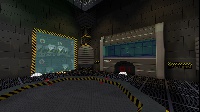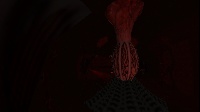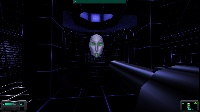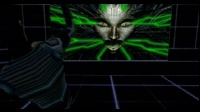System Shock 2
Playtime: 18.2 Hours
Finished 01 July 2023.This playthrough was done on the Steam version of SS2, which I think contains some additional patches and basic mods for compatibility and resolution support (this version runs nicely in 4K), but did not use any other mods for textures, balance and difficulty fixes, or any common INI changes for weapon degredation, respawns, etc. It was done on a completely vanilla Hard difficulty as a Navy character specializing mostly in standard and heavy weapons; I imagine this is quite the generic beginners' build but it was still very fun! My final loadout was the wrench, assault rifle, shotgun, grenade launcher, and stasis field generator, and enough ammo for each to arm a platoon. I stuck with the heavy combat armor because I was tired of switching the powered armor on and off when combat is so sparse in this game, and ran 2 statbooster implants for most of the game (after getting the O/S upgrade for it).
As for my character build, I went heavy into strength for inventory space & wrench damage, since I decided to carry around so many weapons. I also had 5 endurance and agility, which were boosted to max by my implants; I didn't really have a need to go beyond 6 for any stat. My tech skills were focused on hack and maintenance, which were both at 5 by the end of the game. They're quite basic and obvious choices, but due to the game's weird balance, I don't think I would have benefited from any of the remaining three (repair, modify, research). As previously mentioned, I maxed out the standard and heavy weapons skills. To complement these choices, I took the O/S upgrades Lethal Weapon (for a free melee damage boost), Sharpshooter (for a very useful ranged damage boost), Cybernetically Enhanced (for dual implants), and Speedy to get a free speed boost at the end of the game.
Just like its predecessor, System Shock 2 was a great experience from beginning to end and absolutely a worthy sequel, surpassing the lofty expectations that I had after beating the first game. In many ways I'd consider the 2 games equals as ar as my opinion of them is concerned; they perfectly nail the lonely vibe of wandering through a derelict spacecraft drifting through unknown space with inconceivable horrors on board. Having just beaten it recently (at time of writing), I'm interested to see how my opinion of this game settles, but at the moment it's very close between SS1 or SS2 to be my favorite game first player in 2023; I can't believe I waited this long to give either one of them a try.
The plotline for this game takes place as a direct, but not immediate sequel to System Shock 1. 42 years after the events on Citadel Station, a reformed TriOptimum Corporation sends out mankind's first exploration vessel capable of FTL, to explore beyond the bounds of our solar system. Half a year later, they detect a strange transmission from Tau Ceti V, 12 light years away from Earth; the resulting expedition down to the surface ultimately leads to the downfall of the Von Braun and its crew, and the events of System Shock 2. I really liked the background story and characters in this game, because the writing took great care to closely but reasonably link the events of the 2 games together, creating a natural-feeling progression in time while not leaning too hard on the same characters repeatedly in contrived fashion for easy fanservice. The major plot twist of SS2, learning that the signal on Tau Ceti V was from SHODAN on the crashed Beta Grove that you jettisoned as the Hacker on Citadel Station, is a stunning moment and ultimately a stroke of genius in my opinion. In SS1, it's such a simple and straightforward event - you got rid of Beta Grove, and it's no longer a problem. This revelation makes you think back to SHODAN's influence on Citadel Station - remember, Gamma Grove's life support was shut down AFTER it was jettisoned by the onboard crew, meaning that SHODAN still had a presence on the disconnected grove, and that the Jettisoned Alpha, Beta, and Delta groves would similarly end up spawning 3 more SHODAN instances. Meanwhile, Beta Grove being chosen by SS1 SHODAN for biological experimentation in heavily irradiated and toxic environments also leads to the concept of the Many developing into a perfected lifeform during that 42-year period. Note that the groves were safely jettisoned with a blast to destroy the connector and propel the unattached grove away from the station, making all of this plausible. I don't know if this plotline was designed in SS1 with the intent of using it as a building block for SS2, but it fits perfectly in the lore. There is a questionable aspect though, in that this grove managed to travel 12 light years in only 42 years, so this grove was going absurdly fast. Someone apparently tried to calculate the feasibility of this, also delving into the possibility of relativity coming into play and the Von Braun's computers miscalculating time at FTL speeds - apparently, it's not impossible but it's certainly still not very likely under current scientific theory.
Digging more into trivia, you learn that TriOp nearly went under after Citadel and was bought up by a former career gangster, Anatoly Korenchkin, who eventually shoehorned his way into leading the Von Braun expedition as TriOp's CEO. Meanwhile, William Bedford Diego, who was the son of Edward Diego (the genesis of the SS1 crisis) was constantly haunted by his father's horrible legacy, leading to his joining the UNN and eventually leading to his involvement as the officer in charge of the Rickenbacker, fiercely opposing and distrusting Korenchkin. And as you discover more of their intertwined stories throughout the game, you see how Korenchkin's susceptibility to greed & power traps him under the influence of the Many, while Diego's mistrust of Korenchkin and his determination to overcome his father's tainted legacy allows him to finally pull away from the Many in his final moments aboard the Rickenbacker, being the only one of the crew to break free from their hold and pulling out his own Annelid worm parasite like a boss. And this is only a brief overview of a single storyline, albeit one of the more impactful ones. Marie Delacroix's early suspicions and her heroic actions in stifling both the Many and SHODAN provides many key hints and directions throughout the game, very reminiscent of Rebecca Lansing from SS1. On the Ops deck, a small group of Von Braun security staff are able to withstand the seduction of the Many and enforced martial law to prevent the Many from gaining hold, holding out for a while until they were eventually overwhelmed by Hybrids. On Hydroponics, stories of scientist staff bringing aboard egg samples and experimenting with them, one in particular creating the technology for the cyborg midwives under direction of the Many. And the earliest victims on the Rickenbacker and in sections of the ship embedded within the Body of the Many, one of whom even documents his own capture and death. Numerous other interesting and meaningful storylines are interwoven across the decks of the Von Braun, each adding valuable context and depth to the setting. Just like SS1, I found the implementation of the logs in this game to be among the best in any game I've played; so many other games only use them as convenient "storybuilding" tools that also just give important codes and stuff, or for disjointed commentaries on ancient traditions and stuff (looking at Uncharted, Tomb Raider, etc.).
The anchors for the plot in this game are the 2 main antagonists in the Many and SHODAN, which are written brilliantly as foils to one another. However, it's probably worth noting that SHODAN seemingly isn't even in the game at the beginning, instead choosing to assume the identity of Janice Polito, the head scientist of the Von Braun who committed suicide because she couldn't bear to witness the disasters any longer. It's not until about halfway through the Von Braun that you come upon her corpse, upon which SHODAN drops the act; it's the big twist of the game and is very well executed, but ironically it's immediately spoiled by the fact that SHODAN is on the box art... and SHODAN's part in the story has already been discussed so thoroughly since the game's release that this is probably common knowledge by now. Regardless, I really liked the way the plot in the game revolves around 3 opposing factions, with a certain amount of dramatic irony knowing that SHODAN will eventually betray the soldier, as they did Delacroix and all the characters from SS1. Just like on Citadel Station, SHODAN sees itself as a god who should be able to subjugate, manipulate or destroy all life on its own whims. Driven by some incomprehensible lust for power, it considers the Many a failed experiment even in spite of their evolutionary success as the Many refused to be mindlessly subservient to SHODAN.Ironically, there is no logical motive for SHODAN to be as unequivocally evil as it is; as a self-proclaimed perfect machine it still manages to be trapped by its ego, leading to its downfall. This ego is transmitted in the way it presents itself, intentionally adding the stutters and effects to its speech to make itself more intimidating (not heard when imitating Polito). The "machine perfection" comes into play primarily through her craftiness; its schemes and empty promises managed to decieve just about everybody she came into contact with, and it always seems to have a way out. In SS1, it duplicated itself onto each of the Groves' processing systems and managed to survive Citadel Station. In SS2, the ending stinger shows that she managed to take over the autodoc on Tommy and Rebecca's escape pod, seemingly overwriting Rebecca's mind. To be honest, I'm not a big fan of that scene since it sets up a sequel too plainly; there's not much to really think about, and little mystery left to the player since we know she's still alive now. SS2 as a followup to SS1 managed to make sense as a sequel while still leaving the story of SS1 complete, but the addition of this scene makes the Soldier's fight feel somewhat meaningless by comparison. There's also a number of logical issues like the amount of power on the pod and future setting; it's unlikely that another human expedition would just happen to also pass near Tau Ceti V and simply using the Von Braun as a doomsday device again for Earth would be more than a bit contrived.
As the antithesis to SHODAN in this game, the Many are the new "organic" faction - a psionic hivemind originating as SHODAN's biological experiment on Beta Grove. With its own goal to propagate its influence over other lifeforms, it seeks perfection under a unified hivemind, assimilating the crew of the Von Braun to gain their knowledge and managing to actually overthrow SHODAN, forcing the AI into a corner, and setting the wheels of SS2 into motion. It's interesting how SHODAN's creation is so ideologically opposite from itself, yet manages to overtake it by learning from the crew instead of destroying them. Several audio log chains on the decks of the Von Braun detail how XERXES, the control AI for the ship's engines and security, was easily hacked by technical personnel, how medical and hydroponics scientist staff were able to incubate the annelid eggs and create the midwives as caretakers, and how Korenchkin and Diego were taken over under their influence, essentially ceding control to the Many. With all that being said, though both SHODAN and the Many are critical existential threats, I found it interesting how the Many consistently considered their influence to be a gift and a benefit to Earth, rather than conquest. They are correct in a sense - in merely years of evolution the Many were able to evolve a consciousness and understanding of language, comprehension of purpose, etc. If this was possible in the vacuum of Tau Ceti V, what kinds of evolution would be possible if it had knowledge from the entire human race? This illusion is broken down somewhat by their incongruous actions, however - from the very beginning of the game the Hybrids and other creatures are instantly hostile, revealing their intentions despite their honeyed words. Throughout the game they struggle to comprehend your continued resistance, while still sending goons to hunt you down. I don't think they are a truly evil entity though, since their dying words as you destroy them leading up to the end of the game are of their lament in their death, but also a cautionary warning of SHODAN (even if it's a bit too late by then) - there doesn't seem to be much resentment in their words. The general attitude of the Many makes me wonder about different paths that could have been possible in this game but never happened - cooperating with the Many instead of SHODAN, for example. I'm honestly a bit miffed that they are completely destroyed in this game, as I think I would prefer for them to carry on in SS3 over SHODAN.
To finally move into some of the game's qualities that are a bit more separate from the plot and characters, the feeling of the Von Braun is an amazinng, haunting atmosphere. Each deck is large and convoluted, yet feels purposeful - something that SS1 couldn't really manage to fully achieve with its labyrinthian maps. Sectors are marked in each map with reasonable descriptions fitting the theme of each floor, and each area visually matches its purpose far more than the first game. Perhaps this doesn't seem like too big of a deal, but keeping mind even games like Half-Life just a year prior have plenty of nonsensical areas and geometry in the environment, levels as detailed as they are in SS2 stand very far out in its crowd. The ship is generally very dark, with lots of corners where things can hide and ambush you, and the level design made it difficult to truly be complacent about your surroundings; I felt like I always needed to keep an eye out for anything that might ambush me from behind, making me take exploration very slowly and methodically. The sound design, both of the ship's quiet ambience and of the creeping noises of hostiles is fantastic as well and really ties the game together, creating a visual and audial experience that locks you down with a perpetual feeling of being trapped in the unknown, enhanced further by the grotesque forms of the Many and the inherent fear of rogue mechs, of which many (like the protocol droids) were originally meant for more beneficial purposes. A few specific zones in the game had respawns a little too frequently for my liking, with some of them even feeling kind of glitchy (like Hybrids spawning right behind a door you just closed in Engineering). For better or worse, the last few areas in the game see quite a drastic shift in the environment. Once on the Rickenbacker, the Soldier should be powerful enough to very confidently blast through most of the remaining enemies (though the difficulty does spike quite a bit), exploration is discouraged with no map & very complex yet linear pathways, and the scale of the tasks and enemy spawns is geared far more towards an action heavy environment than a mysterious one. This continues somewhat for the rest of the game; I don't particularly dislike it but it's very clear that these segments were very heavily rushed to completion. The Many was a pretty neat boss fight, though it was trivialized by my character's build. On the other hand, SHODAN's boss fight soon afterwards was a complete joke - I was able to kill it with only 4 grenades (3 for shields, 1 for the core). As cool as SHODAN's domain is to explore again (it's just SS1 medical in all fairness), that felt mostly like a budgetary decision and Delacroix's explanation for the FTL-VR melding was pulled out of someone's ass for sure. The ending was also really funny, though it did also break the atmosphere a bit. Nevertheless, any complaints that I would have here are very minor; by my own preferences, this game kept me entranced from start to finish.
Lastly, to discuss the gameplay - the main reason why anyone would want to play this game repeatedly and probably where SS2's biggest issues lie. To start, the MFD interface is back, heavily modified but still familiar to the way things worked in SS1. I got used to it really quickly, and I honestly found it quite intuitive so I didn't have much of a problem - but it plays very differently than even its contemporaries so it could definitely throw people off a bit. It is somewhat annoying that all of the weapons in this game take a full column of inventory slots, so a pistol and a giant fusion cannon somehow take the same amount of space and effort to carry. I think that could have been leveraged better. Ranged weapons also tended to break down a bit too quickly for my liking, which was annoying but didn't actually hurt the experience too much since it's not difficult to get a ton of maintenance tools. Armor and melee weapons never degrading at all is quite funny though, I don't really understand why that decision was made. As far as the Psi mechanics go, I didn't use it at all so I don't have any real gripes with it, other than the fact that you need to spend a weapon slot on a Psi amplifier to access it.
The real problem with SS2 in my opinion is the extremely poor game balance, which I found was a pretty big step back from SS1. SS2 has a fairly old-school method of defining character builds by modern standards, where it is very easy to muck up your build with limited upgrade resources to a point where it's extremely difficult (but never impossible) to proceed. A lot of skills that you can waste your points on are traps - Modify and Repair are completely worthless, as is Research beyond level 1 unless you're planning on a very specific build. Many of the best Psi powers are very low in the Psi tree, while higher level abilities get very specific and become questionably useful. But above and beyond all else is the horrible weapon balancing, which really heavily railroads most builds into a limited few archetypes with little deviation. In short, Standard weapons are absurd - you get the wrench right at the start of the game and the pistol before any other weapons. Ammo for the pistol, shotgun, and later assault rifle are all plentiful and extremely powerful, with options of different ammo types being able to effectively target any enemy type. Compare this to energy weapons, which you do not see in the first sector at all and are almost useless against organic targets, the most common enemy type in the game. Or against exotic weapons, which require extensive research, are not found until more than halfway through the game, and have severe ammo constraints. Heavy weapons make for good secondary armaments and are relatively well balanced, but the first weapon (grenade launcher) is both the most powerful and most versatile of that group. Psi can also be considered as an interesting and viable alternative, but is not as powerful while also requiring a very rare resource in Psi hypos, which are the only efficient way to regain Psi power. What all of this means is that most playthroughs will typically involve at least some standard weapons involvement, with final builds being standard+heavy, melee/exotic+heavy, melee/exotic+psi or standard/psi - energy weapons are simply not viable in the long run due to the enemy distribution overwhelmingly being organics/annelids the entire game. These railroaded builds are very fun for sure, but I feel like my interest in replaying SS2 is diminished somewhat beyond maybe a melee+psi run because of it.
With the effective cancellation of SS3, it seems like this game will continue to remain the last in the saga, but at least it ends with a perfect record. The recent release of the SS1 remake has revived a lot of interest in the world, and the faithfulness of Nightdive towards the world has certainly revitalized hopes for an enhancement of this game as well. All I can hope is that a potential remake is able to capture the atmosphere that made this game so distinct.





